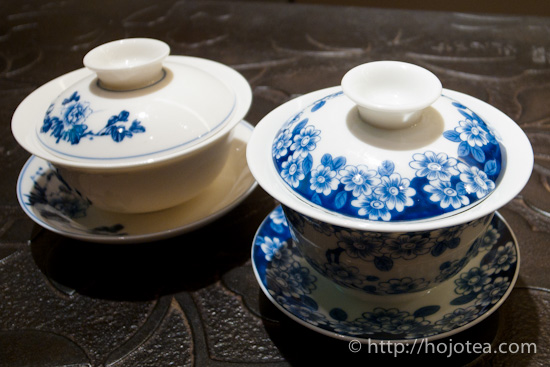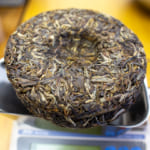- HOME >
- Teapot and Tea Equipment
The effects of porcelain and bone china on the taste of tea
Have you ever wonder whether porcelain and Bone China ware can also affect the taste of tea? In fact, these two materials give different results in both body and aftertaste.
Bone China and Porcelain noticeably changes the taste
Many tea drinkers are aware that clay teapot can alter the taste and flavor of tea. However, very few may pay attention to the effect which porcelain and Bone China also alters the taste of tea. You might think that the differences are marginal. But if we compare both materials side by side, you will be surprised at how noticeable the differences are between Bone China and porcelain. I conducted a tasting experiment using porcelain, Bone China and glass tea cup. I used glass as a control.
The result
- After Taste :porcelain > glass > bone china
- Body :bone China > glass > porcelain
The bone China clearly increases the body, while the porcelain decreases the body. On the contrary, the porcelain increases the after taste. The glass tea cup gave the body and after taste just in between porcelain and bone China.
We must care about the combination effect
In actual application, you may combine tea cup with various types of teapot or even tetsubin to obtain the desired taste. If you are using Nanbu tetsubin (cast iron kettle) or a good natural clay teapot for brewing tea, these tea wares will increase the aftertaste of tea. These materials contain iron ions that can change the taste of water. When I make tea using these tea wares, I prefer to use a Bone China cup to serve the tea. Nanbu tetsubin and natural clay teapot enhances the after taste while Bone China enhances the body. Using this combination, I can enjoy tea with both stronger body and aftertaste.
Why can Bone China increase the body of tea?
In my humble opinion, Bone China can increase the body of tea because of calcium added during its making process. According to the tradition, cow bone ashes were added into Bone China during the production. That is why it was referred as “Bone” China. Today, animal bone ashes are very seldom used in the production of Bone China. Instead of using cow bone ashes, the producers add in 30% (or more) calcium phosphate Ca3(PO4)2 .
In my understanding, the presence of calcium increases the body of water and tea. If you are familiar with Bone China ware, you will know that the surface of bone China is usually glazed with glass. During the glazing process, some calcium could be eluted into the glazing layer. As a result, the body of tea will be enhanced when we use a Bone China.
Related Articles
How to get the latest update on HOJO?
1. Follow Twitter, 2. Click "Like" on Facebook, and 3. Subscribe in newsletter. You can have the latest tea news from HOJO.
 Subscribe the Newsletter to enjoy the privileges
Subscribe the Newsletter to enjoy the privileges- You may receive a free sample upon purchase, or you may have the priority to purchase special products. So please remember to subscribe our newsletter as well as the social network.
- New Arrival of Akitsu Mumyoi and Nosaka Rough Clay Teapot
- A wide selection of teaware by Watanabe Tozo, a Sado-based artist of Mumyoi-yaki, has just arrived. This time, …
- Mang Fei Ripe Pu-erh Tea 2023 – Small-Batch Production from a Renowned Region
- Mang Fei Ripe Pu-erh Tea 2023 is now available. This is one of the highest-quality ripe pu-erh teas among our …
NEW ARTICLES
 Development of Firewood Roasted Hojicha Using Naturally Grown Tea from Yunnan
Development of Firewood Roasted Hojicha Using Naturally Grown Tea from Yunnan- We are currently staying in Yunnan Province for tea production. As the season nears its end, tea trees with pa …
 Exploring the Food Culture of Yunnan: Where Minority and Sichuan Cuisines Meet
Exploring the Food Culture of Yunnan: Where Minority and Sichuan Cuisines Meet- We are currently staying long-term in Yunnan Province for spring tea production. On rainy days or when there i …
 New Arrival of Akitsu Mumyoi and Nosaka Rough Clay Teapot
New Arrival of Akitsu Mumyoi and Nosaka Rough Clay Teapot- A wide selection of teaware by Watanabe Tozo, a Sado-based artist of Mumyoi-yaki, has just arrived. This time, …
 Managing Yunnan White Tea — Insights from the Field
Managing Yunnan White Tea — Insights from the Field- Since March 25, we have been in Yunnan Province, fully engaged in the production of white tea. In this column, …
 Mang Fei Ripe Pu-erh Tea 2023 – Small-Batch Production from a Renowned Region
Mang Fei Ripe Pu-erh Tea 2023 – Small-Batch Production from a Renowned Region- Mang Fei Ripe Pu-erh Tea 2023 is now available. This is one of the highest-quality ripe pu-erh teas among our …
 Yunnan Tea Trends 2025: Insights from the Fields
Yunnan Tea Trends 2025: Insights from the Fields- Since March 25, we have been in Yunnan Province. We will stay here until May to conduct tea production, packin …
 Why Do Some Teas Taste Astringent? Exploring the Causes and Mechanisms of Astringency
Why Do Some Teas Taste Astringent? Exploring the Causes and Mechanisms of Astringency- Tea can range from having no noticeable astringency to possessing a very strong one. What causes this astringe …
 The Impact of Heat Sources on Tea Flavor
The Impact of Heat Sources on Tea Flavor- It is widely recognized that the material of a kettle plays an important role in shaping the taste of water fo …
 New Release of Tang Li Shan Ripe Pu-erh Tea 2023
New Release of Tang Li Shan Ripe Pu-erh Tea 2023- We have released the 2023 edition of Tang Li Shan Ripe Pu-erh Tea. Tang Li Shan refers to a mountain located o …
 The New Release of Dong Shan Raw Pu-erh Tea 2023 and Jasmine Silver Needle
The New Release of Dong Shan Raw Pu-erh Tea 2023 and Jasmine Silver Needle- We have released Dong Shan Raw Pu-erh Tea 2023 and Jasmine Silver Needle. Dong Shan Raw Pu-erh Tea 2023 We hav …
Category
- New Arrival at HOJO Online Shop
- Featured Articles
- Newsletter
- Types of Tea
- Origin of Tea
- Teapot and Tea Equipment
- Tea Column
- How to enjoy tea
- Tea Processing
- How to choose quality tea
- Tea constituents and functional effect
- Safety of Tea
- Foods
- Tea Business Operation
- Hobby and Outdoor Activity
- Ranking of Tea
- Video
- FAQ
- Media Release
Profile

- AKIRA HOJO
- I invite you to experience my tea selections.I was born in Nagano, Japan. In university, I studied agricultural chemistry, and I have the master degree in food science. I worked in Japanese food industry for 10 years. I involved in R&D, QC and QA. As a factory manager, I implemented ISO9000 series and managed the factory.
- The Art of Tea Magazine
- We posted the article on “The Art of Tea Magazine No.9, the magazine is published in Taiwan. We featured …
- New Straits Times
- The Malaysian National Newspaper, New Straits Times featured HOJO Tea on 17-Oct-2007.
Shop Info

Address:Lot No. T-215, 3rd Floor, The Gardens Mall, Mid Valley City, Lingkaran Syed Putra, 59200 Kuala Lumpur
Tel: +603-2287-4537
Business Hour: 10am to 10pm
















